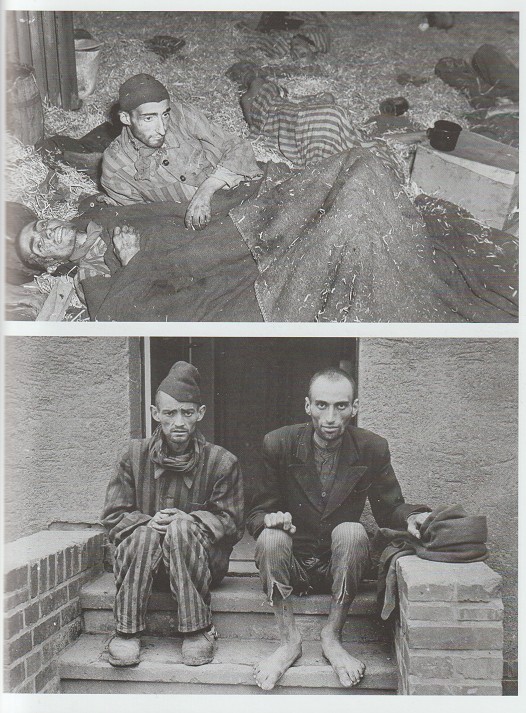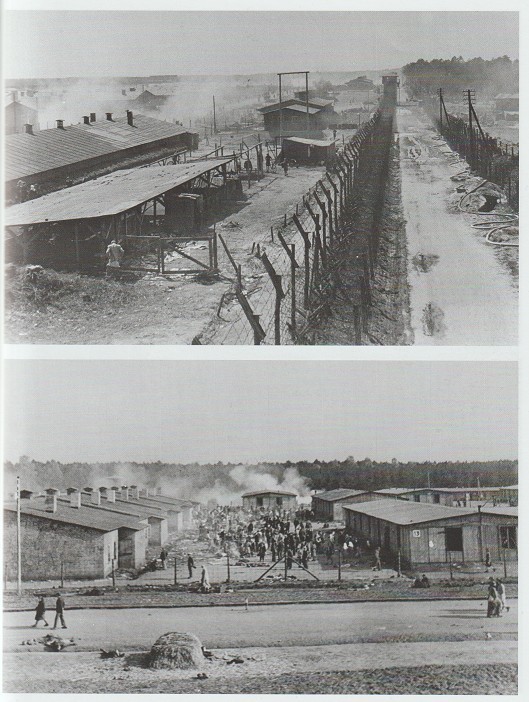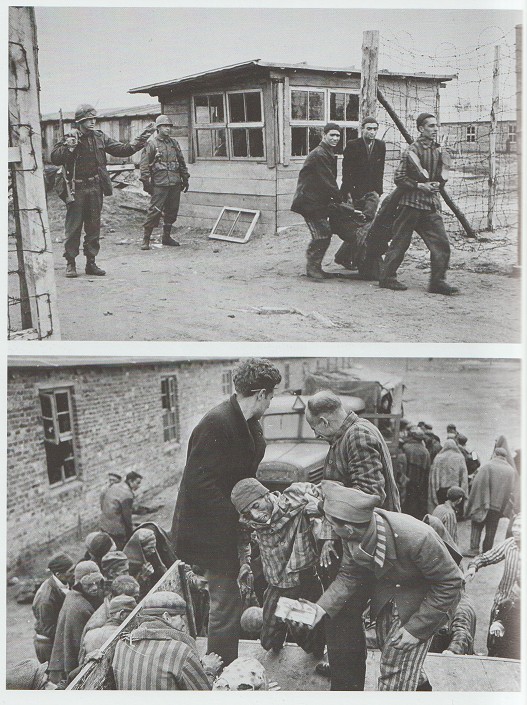HISTORY:
** As the Allies closed in on Hitler’s Germany the horror and scale of the Final Solution and concentration camps became all too apparent. This latest Images of War book provides the reader a truly disturbing insight into the Nazi’s brutal regime of wholesale murder, torture and starvation.
While the Germans attempted to hide the evidence by demolishing much of the camps’ infrastructure, the pace of the Soviets’ advance through Poland meant that the gas chambers at Majdanak near Lublin were captured intact.
Auschwitz had received over a million deportees yet when liberated in January 1945 only a few thousand prisoners were there as the vast majority of surviving prisoners had been sent on forced death marches to more westerly camps such as Ravensbrück and Buchenwald. Conditions in these camps deteriorated further due to overcrowding and the spread of deadly diseases.
In every camp shocking scenes of death and starvation were encountered. When British troops reached Bergen-Belsen in April 1945, there were some 10,000 unburied dead in addition to the mass graves, in addition to 60,000 starving and sick inmates in utterly appalling conditions.
The words and images in this disturbing book are a timely reminder of man’s inhumanity to his fellows and that such behaviour should never be repeated.**
** Quoted from the back cover of the book and the Pen & Sword website.
THE BOOK:
Pen & Sword Books has released Liberation of Nazi Concentration Camps as part of their Images of War series of books. It is a 144-page softcover book, 7.4 x 9.7 inches in size. Included with the text are black and white photographs. The book has a 2023 copyright, a publication date of August 8, 2023, and the ISBN is 978-1-3990-4877-4.
CONTENTS:
Preface
Introduction
Chapter One
- Liberation of the Polish Concentration Camps
Chapter Two
- Liberation of German and Austrian Concentration Camps by US Forces
Chapter Three
- Liberation of German Concentration Camps by French, British and Canadian Forces
Chapter Four
- Liberation of German Concentration Camps by Soviet and Polish Forces
Appendix I
- List of Concentration Camps and Sub-Camps
Appendix II
- Most Populated Liberated/Captured Concentration Camps and Death Camps
THE TEXT:
Author Ian Baxter provides a well written and informative text detailing various German concentration camps and their discovery and liberation by the allies during World War II. There are a total of 19 pages of text, not including the page titled “About the Author” or Appendix I and Appendix II. The remainder of the book is dedicated to the photographs and the captions associated with them. Even with the limited number of pages of text, Ian Baxter goes into great detail with a no-nonsense type of writing that provides a wealth of information on specific concentration camps, the number of buildings in the various camps and what the buildings were used for such as administration buildings, barracks, gas chambers, and factories, the types of forced labor factories and what was produced in them, the number of internees the camps held, the number of internees that were killed or had died from things such as starvation, disease or suicide, the methods of death used and the disposal methods of the deceased, the numbers of internees that survived, the camps that were closed due to the approaching allies and what was done by the Germans to dismantle and hide proof of the camps and the crimes that took place in them and which country’s military discovered and liberated the camps and their actions against the remaining axis forces in the camps as well as the nearby civilians. In addition to his own words, Ian Baxter has also provided quotes from Red Army General Vasily Petrenko, commander of the 107th Infantry Division, American Lieutenant William Cowling of the 6th Armored Division, British Lieutenant S. Charlton of the 53rd Reconnaissance Regiment and others. I feel that Ian Baxter has covered the liberation of the various concentration camps well and has provided the information in an easy-to-read format which the detailed oriented reader will benefit from. Ian Baxter doesn’t use what I refer to as fluff writing where a large amount of non-essential extra text is provided just to help fill the pages. As I read through the text, I didn’t notice any spelling or grammatical errors. Grammar and spelling might not be an important factor to everyone however it is something that I take notice of and pass on my findings.
THE PHOTOGRAPHS:
A total of 175 black and white photographs are included in this volume. There are no color photographs featured. Author Ian Baxter chose subject specific photographs and did not include photographs that strayed from the main subject of the book. Most of the photographs are clear and easily viewable; however, a few of them are somewhat blurry and a few of them appear to be too dark, while others appear to be too light. This can be typical for the discussed period of history and the quality of the photographs is of no fault of the author and they do not take anything away from the book. I have seen some of the provided photographs in other publications dealing with the same subject matter, however the majority of them were new to me. There are several excellent photographs of what the liberators found when they entered the camps showing the terrible conditions in which the internees were forced to live and work and the horrors they had been forced to endure. Other photographs include images such as an assortment of the internees’ possessions such as cutlery, clothing, shoes, as well as their hair after it had been cut off, ground level and aerial views of different concentration camps and the various buildings, electric fences, and the infamous gas chambers and crematorium ovens, allied and axis members and their uniforms and weapons, period clothing of the internees and civilians, several pictures of the internees in various locations such as in their barracks, standing behind barbed wire, and in rail cars. In addition to the previous listed subjects, one can correctly assume, due to the subject of the book, there are numerous photographs of deceased internees shown during their time under Nazi control and also after allied liberation. There also images of deceased German soldiers that had died from retaliation from the allied soldiers and the internees themselves. The reader also needs to be aware that found among the photographs are images of nude internees as well. The majority, if not all, of the photographs will prove to be of great interest to anyone interested in the liberation of the various Nazi operated concentration camps during World War II due to the details they contain.
THE CAPTIONS:
The captions are well written and explain the accompanying photographs nicely. The captions go into very specific detail as to the actions taking place, dates and locations, concentration camp names, individual’s names and military rank, military units, personal quotes, and other such information. As I read through the captions, I didn’t notice any spelling or grammatical errors. I did notice that the caption for the photograph on Page 76 is incorrect. It states that survivors are being deloused by men of the 14th Armoured Division, however the photograph clearly shows the prisoners being deloused by another survivor. I was impressed by Ian Baxter’s captions as they are very helpful to the reader due to their detailed content as opposed to other captions that I have seen that are very brief and lacking in detail.
CONCLUSION:
As with the other volumes of the Images of War titles from Pen & Sword Books I was impressed with this book. This is a very nice reference book that contains a well written informative text, many subject specific photographs, well detailed captions and more, all detailing the liberation of the Nazi concentration camps by allied forces during World War II. As with the other Pen & Sword Books titles, I would have no hesitation in recommending this book to others as it will be a welcome addition to one’s personal military reference library. This title will make a nice companion to Ian Baxter’s book, Hitler's Death Trains - The Role of the Reichsbahn in the Final Solution.
Pen & Sword Books’, Liberation of Nazi Concentration Camps, is also available digitally from:
Amazon
Apple
Barnes & Noble
Kobo
PRICE
UK £14.99 / US $26.95
https://www.casematepublishers.com/
This book, from Pen & Sword Books, was provided to me by Casemate Publishers. Please mention that you saw the book reviewed here on the KitMaker Network when you make your purchase. Thank you.


































